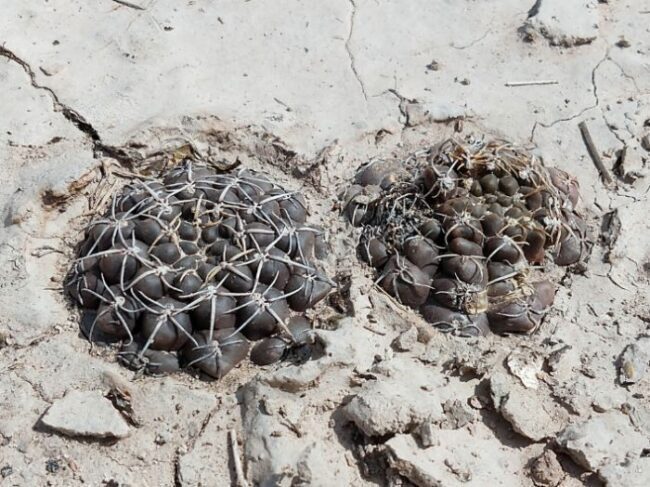Plant
Cool and easy to grow Gymnocalycium Origin, origin and how to grow.
Gymnocalycium is one of the most robust species to manage.
It is a cool and varied species with a very good balance of both ornamental and collecting value.
Origin
Derived from the Greek ‘gymnòs’ (naked) and ‘càlyx’ (calyx), referring to the calyx of a flower which is ‘naked’ as it has no protective scales or hairs.
Habitat
The genus Gymnocalycium includes numerous globular cacti, which are widely distributed, mainly in South America.
 source:https://uk.inaturalist.org
source:https://uk.inaturalist.org
Features
It is generally dark green and can reach various sizes from 2-3 cm to 40-50 cm, depending on the species.
Larger species grow taller and are oval in shape.
They have nodules on their stems, each with a spinous locus.
The ‘areole’ is a button-shaped bud with spines, typical of cacti.
Gymnocalycium spines are generally curved and tough.
 source:https://uk.inaturalist.org
source:https://uk.inaturalist.org
Flowers are large and, depending on the species, variegated and brightly coloured, including white, pink, yellow, orange and red.
The flowers are considered to bloom in spring and summer, but depending on management they can bloom many times throughout the year.
 source:https://uk.inaturalist.org
source:https://uk.inaturalist.org
Type
Gymnocalycium has several species.
G.achirasense
G.andreae
G.anisitsii
G.baldianum
G.bayrianum
G.bodenbenderianum
G.bruchii
G.cardenasianum
G.damsii
G.denudatum
G.gibbosum
G.horstii
G.leeanum
G.mazanense
G.mihanovichii
G.monvillei
G.multiflorum
G.ochoterenae
G.pflanzii
G.quehlianum
G.saglionis
G.spegazzinii
G.stellatum
G.vatteri
Farming
Avoid direct sunlight and choose a well-lit area.
If necessary, cover plants with sun cloth to prevent sunburn.
Keep Gymnocalycium a few degrees above 0°C.
Water every 3-4 days in spring and summer, less frequently in autumn and completely drained in winter.
Use a well-drained growing medium containing sand, gravel or peat.Standard cactus soils are best.
The need for replanting depends on the species.
Gymnocalycium generally reproduce by seed, but also by oyster mushrooms.
 source:https://uk.inaturalist.org
source:https://uk.inaturalist.org

Code Speed Web Without Plugin Wordpress
Without plugins!How to use syntax highlighting Prism.js.|WordPress
In this article, we will show you how to implement syntax highlighting in WordPress without using a plugin. Syntax highlighting is often used to display source code on websites and blog sites. This website has adopted “Prism.js” after various trials....
Continue readingCode Web Without Plugin Wordpress
Without plugins!Copy and paste, 3 minutes, super easy!How to implement dark mode.WordPress
Implement dark mode in WordPress.No plugin is required. 1. 1.JavaScript description.2. 2.Css description.3. 3.HTML description. 1.JavaScript description. Put the following js code in the header. document.addEventListener('DOMContentLoaded', function() { const toggleButtons = document.querySelectorAll('.toggle-mode'); toggleButtons.forEach(function(button) { button.addEventListener('click', function() { const currentMode =...
Continue readingCode
How to unzip a zip file in the server.
Assume the file you want to unzip is ‘example.zip’. 1. 1:Upload the zip file you want to unzip.2. 2:Creating and uploading unzip.php.3. 2:Access unzip.php.4. 3:Deployment of zip.5. 4:Finish. 1:Upload the zip file you want to unzip. Upload the zip file...
Continue readingCode Security Web Wordpress
How to prohibit access to wp-config.php.WordPress
Prohibiting access to wp-config.php improves site security. You are encouraged to refer to this information to maintain your website. Put the following code in the “.htaccess” file. <files wp-config.php> order allow,deny deny from all </files>
Continue readingCode Web Without Plugin
The one you write in wp-config.php for now.
define( 'WP_DEBUG', false ); ini_set('display_errors','Off'); define('ALLOW_UNFILTERED_UPLOADS', true); define('WP_MEMORY_LIMIT', '100000000000000000000M'); define( 'WPMS_ON', true );
Continue readingPlant
What is a cactus. Origin and characteristics of ‘Cactos’ [1].
The word ‘Cactus’ derives from the Greek word ‘Kàktos’. The term was used by Theophrastus in his book HistoriaPlantarum to describe ‘unknown thorny plants’. The term ‘Cactus’ was subsequently adopted by the renowned botanist Linneo to define the American thorny...
Continue readingCode Speed Web Wordpress
Without plugins!Contact Form 7 How to load js and css only on specified pages.|WordPress
Learn how to make ContactForm7 js and css load only on specified pages in WordPress without using a plugin. Normally, when ContactForm7 is installed, js and css are loaded on every page, which slows down the display speed, but this...
Continue readingPlant
What is Gymnocalycium vatteri?
Gymnocalycium vatteri is a cactus of the genus Gymnocalycium. Native to Argentina-Uruguay in South America, it is rich in varieties and delights horticultural enthusiasts. All of these are seedlings with a tangle of local globe seedlings. It was kept in...
Continue readingPlant
Obregonia denegrii.
One genus and one species of cactus, so majestic and dignified is its appearance that it is known as the ‘TEIKAN’. This is a very rare cactus and one of the most popular cacti, partly because of its beautiful rosette...
Continue readingSpeed Web
Image compression web tool to accelerate website display speed.
There are several ways to improve the display speed of a website, the first effective way is to optimise the size of images. In such cases, it is recommended to use the following image compression web tools. The advantage is...
Continue reading